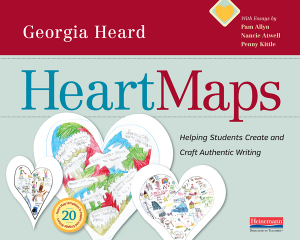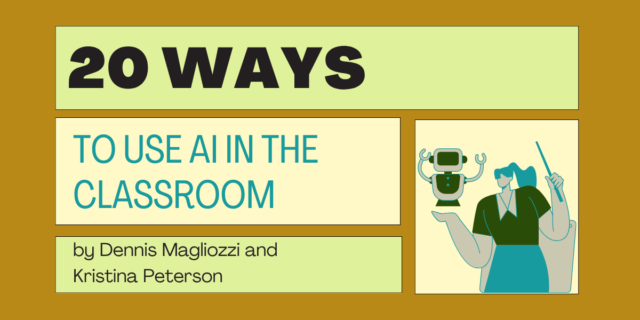
The following essay by Nancie Atwell appears in Georgia Heard’s newest book, Heart Maps: Helping Students Create and Craft Authentic Writing.
What Matters
By Nancie Atwell
Like most of the poems Carl wrote in eighth grade, “The Bowl” was prompted by a posting on his heart map. Between Hans’s paws and potato picking techniques, using just enough words to capture the memory, he’d written breaking the red bowl. When he fleshed out the phrase, it became a poem about family, heritage, love, and regret.
The conclusion is a simple, strong image of a twelve-year-old boy who recognizes that sometimes there aren’t words. No apology will suffice; the little bowl was that big to his mother. All he can do is sweep up the mess he made. But he did give “The Bowl” to her, and she loved it. Carl’s mom told me she hadn’t realized he’d understood what it had meant to her. She was touched by his empathy and grateful to both of us.
The Bowl
In a second
it leaves my clumsy fingers
and crashes to the floor.
You turn at the sound
to find shards of the little red bowl
scattered across the tile.
I look up from the remains
and watch sadness seep
into your face.
and then I realize:
to me it was the whipped cream bowl,
to you it was a bowl of memories,
a tie to your childhood, your children,
your own mother.
I look down at the pieces
of a life
lying in front of me.
Then I turn
to get
the broom.
—Carl Johanson
I, in turn, was grateful to Georgia. Carl would never have written the poem if he hadn’t charted the experiences, people, places, and things that resonated for him, that helped make Carl Carl. The process of mining his heart pulled buried treasure to the surface and made it accessible to him to write about.
Heart maps work for all kids, but their impact on boys is remarkable. The feelings of my male students are just as strong as those of their female classmates, but guys don’t always have the language or an opportunity to express them. I remember being approached one day after school by another mother of boys, two taciturn, woodsman types. “I can’t get over their poetry,” she said. “I didn’t know they had all this inside them—all these things they think about and notice and feel.”
To encourage kids to go deep and be deep as poets and heart mappers, I introduce the process by mining the contents of my own heart. I make sure the entries are particular and evocative. If I show students a heart filled with general categories—favorite foods instead of mashed potatoes as comfort food, rib eyes, and Atomic FireBalls, or reading instead of The Secret Garden, A Wrinkle in Time, The Outsiders, and Pride and Prejudice—they record categories, too, and then they either don’t find ideas that inspire them or produce clichéd bromides about topics like friends, candy, and pets. I’m pretty sure that Carl’s entry Hans’s paws was triggered by my note about Rosie’s pink tongue. A good heart map helps a poet identify and consider what matters to him or her alone.
I also take care not to go too far in the other direction in my demonstration. Plumbing the meaning of an entry comes later, during the act of writing about it. If a teacher requires students to delve into the significance of every idea they post, the generative power of heart mapping is checked. Not every topic will represent an itch worth scratching as a poem, but the act of recording an un-scratch-worthy idea often leads to recording one that’s worthwhile. Heart mapping should feel exciting and intriguing to kids—an opportunity to play wholeheartedly in answer to the overarching question, “What has stayed in my heart?” I created a list of subordinate questions to help kids be specific in their answers. They tape it to the bottom corner of the page on which they draw an outline of their heart and consult it to prompt a variety of discoveries.
Questions to Help Mine Your Heart
What has stayed there? What moments, family members, pets, obsessions, adventures, animals, objects, places, books, fears, scars, friends, teachers, things to eat and drink, journeys, secrets, dreams, delights, crushes, comforts, toys, tragedies, traditions? What’s at the center? The edges? What has stayed in your heart?
At my K–8 school, the Center for Teaching and Learning, student poets answer the question every year; seventh and eighth graders interview the kindergartners to help them fill in their first heart maps. As children grow up, they make new memories, and their vision of what matters changes and grows, too. Carl’s entry breaking the red bowl emerged only on the heart map he created as an eighth grader.
Last year, a decade after Carl wrote “The Bowl,” I heard from his mother once again. The occasion was my retirement as a classroom teacher. She sent me a note that concluded, “Through poems like the one about the broken red bowl, you strengthen our family in love. Although the bowl is long gone, we have the poem.”
The lost heirloom was exchanged for another, a poem that perpetuated its memory and created a new one for Carl’s family. The power of all art, poetry in general, and heart mapping in particular, is how it captures, illuminates, and sustains what matters.
♦ ♦ ♦
Want to give heart mapping a try today? Download a sample from Heart Maps that includes a sample heart map template: “Be the Change That You Wish to See in the World”
 In Heart Maps, beloved author Georgia Heard (@GeorgiaHeard1) shares 20 unique, multi-genre heart map templates to help students write more…and more authentically. Supported with writing ideas, suggested mentor texts, and tips for getting started with heart mapping, Heart Maps is a practical resource for every teacher.
In Heart Maps, beloved author Georgia Heard (@GeorgiaHeard1) shares 20 unique, multi-genre heart map templates to help students write more…and more authentically. Supported with writing ideas, suggested mentor texts, and tips for getting started with heart mapping, Heart Maps is a practical resource for every teacher.


